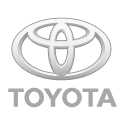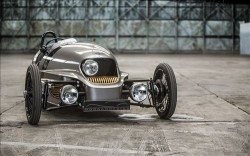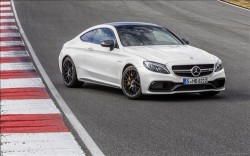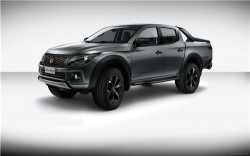Wallpapers
 Sakichi Toyoda (1867-1930), the great industrial entrepreneur
and national hero, was the Japanese equal of Thomas Edison. As recently
as 1985, the patent office listed Sakichi Toyoda as one of the ten most
important inventors in Japanese history. The textile machinery company
that he founded eventually gave birth to the Toyota Motor Corporation.
Sakichi Toyoda (1867-1930), the great industrial entrepreneur
and national hero, was the Japanese equal of Thomas Edison. As recently
as 1985, the patent office listed Sakichi Toyoda as one of the ten most
important inventors in Japanese history. The textile machinery company
that he founded eventually gave birth to the Toyota Motor Corporation.
Origins in Toyoda Automatic Loom —1936
The origins of the company are found as an automobile section of Toyoda Automatic Loom, implemented in September 1933. From an early age Sakichi Toyoda worked on improving looms. In 1891 he obtained his first patent for the Toyoda wooden hand loom. He went on to focus his efforts on the improvement and invention of looms, including a significant number of excellent motive and automatic machines.
In 1924, Toyoda invented the Type-G Toyoda automatic loom with non-stop shuttle change motion, the first of its kind in the world. The Type-G Toyoda automatic loom was a groundbreaking invention containing a number of features such as automatic thread replenishment without any drop in the weaving speed. Platt Brothers & Co., Ltd. of England, a world leader in the loom industry of the time, paid the 1929 equivalent of 1 million yen for transfer of the rights to the Type-G loom. Toyoda later used these funds as seed money to found Toyota Motor Co., Ltd.
As a result of Toyoda's inventions the quality of Japanese looms and textile products jumped to an internationally competitive level.
Quickly thereafter the section produced its first Type A Engine in 1934, used for the production of the first Model A1 passenger car in May 1935 and the G1 truck in August 1935. Production of the model AA passenger car started in 1936.
Although the company is most well known today for its cars, it is still in the textile business.
Establishment of Toyota Motor Co. and WWII 1936–1946
Toyota Motor Co. was established as an independent company in 1937. Although the founding family name is Toyoda, the company name was changed to...
Signify the separation of the founders' work life from home life;
Simplify the pronunciation, and
Give the company an auspicious beginning. Toyota is considered luckier than Toyoda due to the fact that eight is a lucky number, and is the number of strokes it takes to write Toyota in Katakana.
During the Pacific War the company was dedicated to truck production for the Imperial Army. Because of severe shortages in Japan, military trucks were kept as simple as possible. For example, the trucks had only one headlight on the center of the hood.
Fortunately for Toyota, the war ended shortly before a scheduled allied bombing run on the Toyota factories in Aichi.
Start of Commercial Production 1947-
Commercial passenger car production started in 1947 with the model SA. In 1950 a separate sales company Toyota Motor Sales Co. was established (which lasted until July 1982). In April 1956 the Toyopet dealer chain was established.
Today Toyota is one of the top car manufacturers with large market shares in both the US and Europe. It has a small car division, selling under the Daihatsu brand as well as a heavy vehicle division, selling under the Hino brand.
Toyota is Japan's biggest car company and second largest in the world (the largest being America's General Motors) having recently overtaken Ford Motor Company in sales. The company is immensely profitable, and its massive cash reserves dwarf those of many countries. Toyota's vehicles are generally highly regarded for their quality, proficient engineering, and value, but their designs are viewed as anonymous and lacking the flair of smaller manufacturers. Toyota offers one of the largest ranges of vehicles of any manufacturer and does, amongst its more predictable high-volume models, produce a number of exciting sports cars, particularly, the Celica, MR2 and Supra.
Worldwide Presence
Toyota has factories all over the world, manufacturing or assembling vehicles for local markets, including its most popular model, the Corolla. Toyota has manufacturing or assembly plants in the United States, Australia, Canada, Indonesia, South Africa, the United Kingdom and France. Cars from these plants are often exported to other countries. For example, the South African-built Toyota Corolla is exported to Australia, while the Australian-built Camry is exported (in left hand drive) to countries in the Middle East. Between 1997 and 2000, the number one selling car in the U.S. was the Toyota Camry. It was dethroned in 2001 by the Honda Accord, only to regain its place in 2002, with the introduction of a redesigned model.
Toyota also produces a range of SUVs. Indeed, one of its first export markets was exporting its Landcruiser model to Australia in the late 1950s.
Toyota also contributes a great amount of research to cleaner-burning vehicles (See: Toyota Prius). In 2002, Toyota successfully road-tested a new version of the RAV4 which ran on a Hydrogen Fuel Cell. Scientific American made the company its Business Leader of the Year in 2003 for commercializing an affordable hybrid car. In 2004, Toyota showed that it had made its Highlander into the world's first mass-market seven-passenger hybrid SUV.
To gain a higher share in the U.S. domestic luxury car market, Toyota introduced a separate brand called Lexus in 1989, following Honda's (with its Acura division) example. The brand was introduced with two models: the ES 250 , based on Toyota Camry, and the LS 400, which was released simultaneously as the Toyota Celsior in Japan. Since then, the lineup has been expanded with other models based on Japanese Toyotas, and the marque has been successful, receiving many industry awards. Now that it has become the number one selling luxury car brand in the U.S., Toyota is introducing it to Japan in 2005, thus completing a cycle of sorts.
In 2003, Toyota brought two of their popular cars from Japan (including the bB) to America, and created a new badge, called Scion, meaning a descendant or heir. These cars are targeted towards the young, and young-at-heart. Both models, the xA (known in Japan as the Toyota ist) and xB (known in Japan as the Toyota bB) are powered by a 1.5L DOHC I4 engine taken right out of the Toyota Echo (known in Japan as the Toyota Platz), a derivative work of the Toyota Tercel .
Toyota has also been successful in racing, especially in Rally with the Toyota Celica. In 2002 Toyota started racing in Formula One with the Toyota Team Europe (TTE) and is based in Cologne (Germany).
Toyota is also famous in industry for its manufacturing philosophy, called the Toyota Production System. This system is copied worldwide by many manufacturing companies.
 Sakichi Toyoda (1867-1930), the great industrial entrepreneur
and national hero, was the Japanese equal of Thomas Edison. As recently
as 1985, the patent office listed Sakichi Toyoda as one of the ten most
important inventors in Japanese history. The textile machinery company
that he founded eventually gave birth to the Toyota Motor Corporation.
Sakichi Toyoda (1867-1930), the great industrial entrepreneur
and national hero, was the Japanese equal of Thomas Edison. As recently
as 1985, the patent office listed Sakichi Toyoda as one of the ten most
important inventors in Japanese history. The textile machinery company
that he founded eventually gave birth to the Toyota Motor Corporation.Origins in Toyoda Automatic Loom —1936
The origins of the company are found as an automobile section of Toyoda Automatic Loom, implemented in September 1933. From an early age Sakichi Toyoda worked on improving looms. In 1891 he obtained his first patent for the Toyoda wooden hand loom. He went on to focus his efforts on the improvement and invention of looms, including a significant number of excellent motive and automatic machines.
In 1924, Toyoda invented the Type-G Toyoda automatic loom with non-stop shuttle change motion, the first of its kind in the world. The Type-G Toyoda automatic loom was a groundbreaking invention containing a number of features such as automatic thread replenishment without any drop in the weaving speed. Platt Brothers & Co., Ltd. of England, a world leader in the loom industry of the time, paid the 1929 equivalent of 1 million yen for transfer of the rights to the Type-G loom. Toyoda later used these funds as seed money to found Toyota Motor Co., Ltd.
As a result of Toyoda's inventions the quality of Japanese looms and textile products jumped to an internationally competitive level.
Quickly thereafter the section produced its first Type A Engine in 1934, used for the production of the first Model A1 passenger car in May 1935 and the G1 truck in August 1935. Production of the model AA passenger car started in 1936.
Although the company is most well known today for its cars, it is still in the textile business.
Establishment of Toyota Motor Co. and WWII 1936–1946
Toyota Motor Co. was established as an independent company in 1937. Although the founding family name is Toyoda, the company name was changed to...
Signify the separation of the founders' work life from home life;
Simplify the pronunciation, and
Give the company an auspicious beginning. Toyota is considered luckier than Toyoda due to the fact that eight is a lucky number, and is the number of strokes it takes to write Toyota in Katakana.
During the Pacific War the company was dedicated to truck production for the Imperial Army. Because of severe shortages in Japan, military trucks were kept as simple as possible. For example, the trucks had only one headlight on the center of the hood.
Fortunately for Toyota, the war ended shortly before a scheduled allied bombing run on the Toyota factories in Aichi.
Start of Commercial Production 1947-
Commercial passenger car production started in 1947 with the model SA. In 1950 a separate sales company Toyota Motor Sales Co. was established (which lasted until July 1982). In April 1956 the Toyopet dealer chain was established.
Today Toyota is one of the top car manufacturers with large market shares in both the US and Europe. It has a small car division, selling under the Daihatsu brand as well as a heavy vehicle division, selling under the Hino brand.
Toyota is Japan's biggest car company and second largest in the world (the largest being America's General Motors) having recently overtaken Ford Motor Company in sales. The company is immensely profitable, and its massive cash reserves dwarf those of many countries. Toyota's vehicles are generally highly regarded for their quality, proficient engineering, and value, but their designs are viewed as anonymous and lacking the flair of smaller manufacturers. Toyota offers one of the largest ranges of vehicles of any manufacturer and does, amongst its more predictable high-volume models, produce a number of exciting sports cars, particularly, the Celica, MR2 and Supra.
Worldwide Presence
Toyota has factories all over the world, manufacturing or assembling vehicles for local markets, including its most popular model, the Corolla. Toyota has manufacturing or assembly plants in the United States, Australia, Canada, Indonesia, South Africa, the United Kingdom and France. Cars from these plants are often exported to other countries. For example, the South African-built Toyota Corolla is exported to Australia, while the Australian-built Camry is exported (in left hand drive) to countries in the Middle East. Between 1997 and 2000, the number one selling car in the U.S. was the Toyota Camry. It was dethroned in 2001 by the Honda Accord, only to regain its place in 2002, with the introduction of a redesigned model.
Toyota also produces a range of SUVs. Indeed, one of its first export markets was exporting its Landcruiser model to Australia in the late 1950s.
Toyota also contributes a great amount of research to cleaner-burning vehicles (See: Toyota Prius). In 2002, Toyota successfully road-tested a new version of the RAV4 which ran on a Hydrogen Fuel Cell. Scientific American made the company its Business Leader of the Year in 2003 for commercializing an affordable hybrid car. In 2004, Toyota showed that it had made its Highlander into the world's first mass-market seven-passenger hybrid SUV.
To gain a higher share in the U.S. domestic luxury car market, Toyota introduced a separate brand called Lexus in 1989, following Honda's (with its Acura division) example. The brand was introduced with two models: the ES 250 , based on Toyota Camry, and the LS 400, which was released simultaneously as the Toyota Celsior in Japan. Since then, the lineup has been expanded with other models based on Japanese Toyotas, and the marque has been successful, receiving many industry awards. Now that it has become the number one selling luxury car brand in the U.S., Toyota is introducing it to Japan in 2005, thus completing a cycle of sorts.
In 2003, Toyota brought two of their popular cars from Japan (including the bB) to America, and created a new badge, called Scion, meaning a descendant or heir. These cars are targeted towards the young, and young-at-heart. Both models, the xA (known in Japan as the Toyota ist) and xB (known in Japan as the Toyota bB) are powered by a 1.5L DOHC I4 engine taken right out of the Toyota Echo (known in Japan as the Toyota Platz), a derivative work of the Toyota Tercel .
Toyota has also been successful in racing, especially in Rally with the Toyota Celica. In 2002 Toyota started racing in Formula One with the Toyota Team Europe (TTE) and is based in Cologne (Germany).
Toyota is also famous in industry for its manufacturing philosophy, called the Toyota Production System. This system is copied worldwide by many manufacturing companies.
Views: 32894
[Source: Toyota ]
Latest Wallpapers
Following is the list of recent pictures updates on our site.
DieselStation Social



















